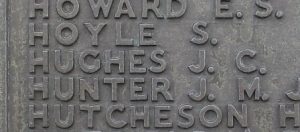Llanbrynmair is a village and community in Montgomeryshire, situated on the A470 road between Caersws and Machynlleth. The community includes several hamlets: Talerddig, Dolfach, Bont-Dolgadfan, Pandy, Cringoed, Dylife and Pennant. The men of Llanbrynmair who fell during both World Wars are commemorated on a war memorial which was originally unveiled in the centre of the village in 1921. It was relocated to Llanbrynmair Community Centre in the 1980’s.
The Great War, 1914-1918
William Abbotts Chidlow, Lance Corporal, 12909, King’s Shropshire Light Infantry. William was born in Llanbrynmair in 1891, the son of John and Jane Chidlow, and was baptised there on 7 March 1891. The family later moved to 13, Brownlow Road, Ellesmere, Shropshire, where William worked as a carpenter for the Goods Department of the London and North West Railway. William enlisted into the King’s Shropshire Light Infantry at Shrewsbury soon after the outbreak of war, and was posted to the 6th Battalion, KSLI. The battalion was attached to 60 Brigade, 20th (Light) Division, and trained at Aldershot and at Larkhill, Salisbury Plain, before landing at Boulogne on 22 July 1915. The Division moved to the Fleurbaix Sector for trench familiarisation and training. When the Battle of Loos was launched on 25 September 1915 the Division fought a diversionary attack towards Fromelles. Later that year it moved north, and fought at the Battle of Mount Sorrel alongside the Canadian Corps. The Division then moved south and fought through the Somme Offensive, at the Battles of Delville Wood, Guillemont, Flers-Courcelette, Morval and Le Transloy, and took part in the advance to the Hindenburg Line in March 1917. Later that year the Division fought at Third Ypres, at the Battles of Langemarck, the Menin Road, and Polygon Wood, before moving south in November, to take part in the Battle of Cambrai. In the middle of December 1917, the Division moved back to Ypres, and wintered in the Salient. William was killed in action during thee first day of a routine spell in the trenches at Ypres on 21 January 1918. The 27-year-old is buried in Railway Dugouts Burial Ground (Transport Farm), Belgium. William is not commemorated on the Llanbrynmair war memorial.
Sidney Craig, Gunner, 92445, Royal Garrison Artillery. Sidney was born at Auchterhouse, Forfar, Scotland in 1888, the son of Peter and Betsy Craig. He had moved to Capel Bach, Bont, Llanbrynmair several years prior to the war to work as a gamekeeper, and married Martha Rowlands on 15 January 1908. Sidney enlisted into the Royal Garrison Artillery at Newtown on 7 December 1915, and was placed on the Army Reserve. He was mobilised on 10 June 1916 and sent to Fort Brockhurst for training. On 2 December 1916 Sidney embarked for France, leaving behind his pregnant wife and three young children, and was posted to the 202th Siege Battery, RGA. On 21 July 1917 Sidney was wounded, and was evacuated to the 3rd General Hospital at Le Treport. On 12 August 1917 he was posted to the 331st Siege Battery, but soon afterwards was wounded in the face, and he returned home on 27 September 1917 for treatment at the Princess Christian Military Hospital, Englefield Green, Surrey and then at the War Hospital at Epsom. After recuperating at Woldingham Convalescent Hospital, Sidney returned to France on 21 April 1918, soon after the death of one of his four children, John Emrys Craig, and was posted to the 17th Siege Battery, RGA. Sidney was killed in action on 2 November 1918, aged 32, just nine days before the Armistice. He is buried in Pommereuil British Cemetery, France. His brother James Lyall Craig died of wounds suffered at Gallipoli in 1915.
John William Daniels, Air Mechanic 2nd Class, 93596, Royal Air Force. John was the son of William and Mary Anne Daniels of Post Office, Llanbrynmair. He was the village postmaster before the war. John enlisted into the Royal Flying Corps on 31 August 1917, and was posted out to Italy, where the British had sent forced to aid the beleaguered Italians holding the frontier. In March 1918 the Royal Flying Corps merged with the Royal Naval Air Service to form the Royal Air Force. John died whilst serving in Italy with the RAF on 23 October 1918, aged 32. He is buried in Giavera British Cemetery, Arcade, Italy.
Daniel Goronwy Evans, Private, PLY/1843(S), Royal Marine Light Infantry. Daniel was born on 1 December 1893, the son of Evan Evans and Margaret Evans of Pentre Lludw, Llanbrynmair. He worked as a waggoner at Tynygors Farm prior to the war. Daniel enlisted at Liverpool into the Royal Marines on 20 December 1916 and was posted to the recruit depot at deal. On 15 January 1918 Daniel joined B Company, Plymouth Division, Royal Marine Light Infantry, and on 23 April 1918 took part in the famous raid on Zeebrugge, where Admiral Roger Keyes led a Royal Naval force which attempted to block the entrance to the harbour. Daniel was among a force of 200 Royal Marines who landed on the Zeebrugge Mole from HMS Vindictive, which was accompanied by two old Mersey ferries and two obsolete submarines, filled with explosives. Daniel survived the raid, and returned to England safely. He was then posted to Archangel, Russia, where he joined a force of Royal Marines aboard the battleship HMS Glory. The British had sent a force to Archangel to assist the Russian Tsarist forces following the Bolshevik Revolution. Daniel took ill at Archangel, and died of disease there on 18 October 1918, aged 25. He is buried in Archangel Allied Cemetery, Russia.
David William Evans, Private, 291417, Royal Welsh Fusiliers. David was the son of Griffith and Catherine Evans of Waenfawr, Pennant, Llanbrynmair. He worked as a waggoner and lived at Trefeglwys, Caersws prior to the war. David enlisted into the 3/7th Battalion, Royal Welsh Fusiliers at Newtown on 11 December 1915, and was initially placed on the Army Reserve before being mobilised on 13 February 1916, and was posted to Park Hall Camp, Oswestry for training. On 20 October 1916 David embarked for Egypt, and was posted to the 1/7th Battalion, Royal Welsh Fusiliers, which was attached to 158 Brigade, 53rd (Welsh) Division. The Division had been evacuated from Gallipoli in December 1915, moving to Egypt to join the EEF, and helped guard the Suez Canal before taking part in operations to drive the Turks out of the Sinai. The EEF then turned its attention onto driving the Turks out of Palestine, and on 26 March 1917 launched its first offensive against the coastal city of Gaza, which guarded the road to Jerusalem. Initial gains during the day were lost when the assaulting divisions lost touch with each other and communication broke down when a thick fog cloaked the battlefield. David was wounded during the battle, being shot in the arm, and did not return to duty until 4 August 1917. By now the EEF had been re-organised, with Sir Edmund Allenby assuming command, and a third offensive was launched against a wider front from Beersheba to Gaza on 31 October 1917. This time the Turkish defences were breached, and the road to Jerusalem now lay open and the EEF began to advance north. On 6 November 1917, 158 Brigade launched an attack on the Khuweilfeh Heights. David was posted as missing during the battle, but had been again wounded, and returned to duty on 2 January 1918. He was wounded for a third time in September 1918, as the Palestinian campaign was drawing to a close, and died of his wounds on 20 September 1918, aged 28. His service papers state that he died at Alexandria, so he should have a grave, but David is commemorated on the Jerusalem Memorial, Israel.
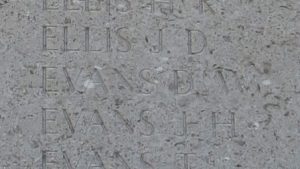
John Ellis Evans, Private, 202940, Welsh Regiment. John was born at Cyfic, Carno in 1898, the son of Morris and Mary Margaret Evans. By 1911 the family had moved to Henefail, Talerddig, Llanbrynmair. John enlisted into the army at Welshpool and was posted to the 4th Battalion, Welsh Regiment. After embarking for France in the autumn of 1917, John was posted to the 14th Battalion, Welsh Regiment, which was attached to 114 Brigade, 38th (Welsh) Division. On 31 July 1917 the Division had launched its famous assault on the Pilckem Ridge, capturing Iron Cross and reaching its objective of the Steenbeek, then played a supporting role in the Battle of Langemarck. The Division was transferred to the Sailly-sur-la-Lys sector in September, and remained in the area over the winter before being moved to positions north of Albert, at Bouzincourt Ridge, at the end of March 1918, relieving the battered 2nd and 47th Divisions. It held this sector, again carrying out minor operations and trench raids, over the coming months. On 10 May 1918, the 14th Welsh supported a raid by the 15th Welsh in Aveluy Wood. Soon after launching their assault, the attacking troops came under heavy artillery fire from their own guns, which had miscalculated their range, and as a result their barrage fell short into their own men. John was among many casualties suffered during the raid, being killed by his own artillery support. The 20-year-old is buried in Martinsart British Cemetery, France.
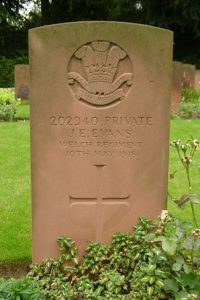
John Rowland Evans, Private, 291699, Royal Welsh Fusiliers. John was the son of John Robert Evans and Anne Evans (nee Jones), of Tŷ Uchaf, Llanbrynmair. He worked as a waggoner on his fathers’ farm prior to the war. John enlisted into the 7th Battalion, Royal Welsh Fusiliers at Machynlleth on 11 December 1915 and was placed on the Army Reserve. He was mobilised on 23 May 1916 and posted to Park Hall Camp, Oswestry for training. John took ill whilst at Oswestry, and was diagnosed as suffering from Scarlet Fever, so was sent to the Isolation Hospital, at Chester. He died there of Scarlet Fever on 14 January 1917, aged 21. John is buried in Llanbrynmair Congregational Chapelyard, Dolfach.
David Richard Foulkes, Private, 90278, Royal Welsh Fusiliers. David was the illegitimate son of Martha Foulkes, of Trefeglwys. He was raised by his grandparents at Trefeglwys, and then by his Aunt, Susan Foulkes, at Pantywain, Staylittle, Llanbrynmair. David enlisted at Wrexham into the 3rd Battalion, Royal Welsh Fusiliers, and was posted to Ireland, where the battalion was on garrison duties, following the Easter Risings. David took ill, and died of pneumonia in Limerick on 12 July 1918. The 22-year-old is buried in King’s Island Cemetery, Limerick, Ireland. He is not commemorated on the Llanbrynmair war memorial.
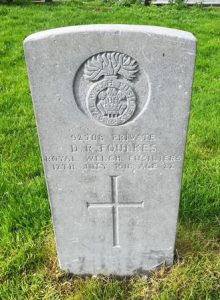
Richard Howells, Private, 41198, The King’s (Liverpool Regiment). Richard was the son of Richard and Jane Howell of Tripp Cottage, Llanbrynmair. He worked as a railway labourer prior to the war. Richard enlisted at Newtown into the Royal Field Artillery, and but in the late summer of 1916 was sent to France and transferred to the 1st Battalion, The King’s (Liverpool Regiment), which was attached to 6 Brigade, 2nd Division. Richard probably joined the battalion in billets at Acheux, where it was resting following heavy losses on the Somme, in time to take part in the battalion’s assault near Serre, during the Battle of the Ancre in November. The battalion then moved back into reserve at Argenvillers at the end of the month, and remained there until 9 January 1917, when it began moving back into the front line in the Somme sector, at Courcelette. The infantry battalions of the 2nd Division were carrying out the usual system of trench rotation. Richard was wounded during this period, and was evacuated to hospital in Étaples, where he died of his wounds on 1 March 1917, aged 35. He is buried in Étaples Military Cemetery, France.
Asa Llewellyn Hughes, MiD, Private, 131, Australian Infantry. Asa was the son of David and Catherine Hughes, of Dafarn Newydd, Llanbrynmair. He worked as a carpenter with his father prior to emigrating to Australia, and the family embarked at London for Brisbane aboard the SS Demosthenes on 7 November 1912. Asa and his father set up business together, but following the outbreak of war, Asa felt the desire to fight for the cause, and enlisted at Ipswich, Queensland into the 25th Battalion, Australian Infantry. Asa sailed from Brisbane with his battalion aboard HMAT Aeneas on 29 June 1915, as part of the 7th Brigade, 2nd Australian Division, and after arriving in Egypt, moved to Gallipoli by early September. Asa was Mentioned in Despatches for successfully reconnoitring in front of the Apex Trenches at Gallipoli on 4 October. The Division was evacuated from Gallipoli in December 1915 and moved back to Egypt, where further training was carried out before the Australians moved to France, and Asa’s battalion landed at Marseilles on 19 March 1916, before entraining for Northern France. On 23 July 1916 the 1st Australian Division attacked the village of Pozieres, suffering terrible casualties over the coming days, before being relieved by the 2nd Australian Division on 27 July. Asa was reported as missing in action during the height of the fighting on 29 July 1916, and was later found to have been killed in action on that date. Oddly, the 26-year-old was reported to have been buried in Rosieres Communal Cemetery Extension, near Corbie, but he has in fact no known grave, and is commemorated on the Villers-Bretonneux Memorial, France.
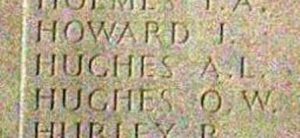
David Hughes, Private, 55223, Royal Welsh Fusiliers. David was born on 20 April 1880, the son of Evan Hughes and Sarah Hughes (nee Jones), of Llanbrynmair. He married Catherine Thomas on 29 April 1901, and the couple lived at Cawy, Llanbrynmair, where their four children were born. David worked as a groom and chauffeur to Daniel Stable, at Plas Llwyn Owen, prior to enlisting in London into the Montgomeryshire Yeomanry. David was posted to France at the end of December 1916, and joined the 2nd Battalion, Royal Welsh Fusiliers, which was attached to 19 Brigade, 33rd Division. David was probably among a draft of reinforcements which joined the battalion at Vauchelles les Quesnoy at the end of December. In the middle of January 1917, the battalion moved into the front line at Clery, and remained in this sector until the beginning of April, when the Division moved to the Arras sector, taking over positions on the Hindenburg Line near Henin. The Division took part in terrible fighting here over the coming weeks, during the Battle of the Scarpe and at Bullecourt, before moving to the rest area at Airaines in July and then took over positions at Lombardzyde on the Flanders coast, where it prepared for a possible assault. By the end of August, it had become apparent that the Passchendaele offensive had stalled, so the 33rd Division was transferred to the Ypres Salient, and the 2nd RWF moved into the line near Polygon Wood by 25 September. On the following day the battalion attacked Polygon Wood in conjunction with an assault by the Australians, but suffered terrible casualties. David was wounded during the assault, and was evacuated to the Hospital at Lijssenthoek, where he died of his wounds on 28 September 1917, aged 37. David is buried in Lijssenthoek Military Cemetery, Belgium.
Isaac Breese Hughes, Private, 25381, South Wales Borderers. Isaac was the son of John Griffith Hughes and Martha Hughes (nee Owens), of Pandy, Llanbrynmair. He worked as a postman prior to the war. Isaac enlisted into the King’s Shropshire Light Infantry at Machynlleth, and embarked for France at some time in early 1917, where he was posted to the 1st Battalion, South Wales Borderers. The battalion was attached to 3 Brigade, 1st Division, and had seen heavy fighting on the Somme during the summer of 1916. Isaac was probably among a draft of 155 men who joined the battalion at Becourt on 4 January 1917. The Division followed the German retreat to the Hindenburg Line in early 1917, and was then briefed for an operation on the Flanders Coast, moving there during the summer of 1917. By September it had become apparent that the Passchendaele offensive had become bogged down, so the Division was recalled to Ypres, and took part in the Second Battle of Passchendaele. After spending the Winter in Flanders, the Division was near Éstaires when the German Spring Offensive caught them, and saw heavy fighting before being moved south tor rest. From 21 August 1918 onwards, the Division took part in the great Allied offensive, launching its assault from the Arras sector, and by 1 October had reached the Hindenburg Line. By 21 October 1918 the Hindenburg Line had been breached, and the 1st SWB had moved into billets at Wassigny. At 23.00 on the following day, the battalion moved forwards to support an assault by the 2nd Welsh, and at 01.20 on 23 October 1918 the Welsh and Gloucester’s attacked. The 1st SWB were not called upon, but the battalion suffered casualties when the Germans opened up an artillery barrage on their positions, killing Isaac and five other men. Isaac was 28-years-old when he was killed that day, and he is buried in Highland Cemetery, Le Cateau, France.
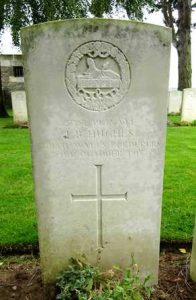
William Hughes, Private, 291246, Royal Welsh Fusiliers. William was the son of Henry Hughes and Harriet Hughes (nee Hucker), of Dolyronnen, Llanbrynmair. He worked as a waggoner prior to enlisting into the 3/7th Battalion, Royal Welsh Fusiliers at Newtown on 20 November 1915 and was posted to Park Hall Camp at Oswestry for training. On 27 June 1916 William embarked at Devonport for Egypt and joined the 1/7th Battalion, Royal Welsh Fusiliers, which was attached to 158 Brigade, 53rd (Welsh) Division. The Division had been evacuated from Gallipoli in December 1915, moving to Egypt to join the EEF, and helped guard the Suez Canal before taking part in operations to drive the Turks out of the Sinai. The EEF then turned its attention onto driving the Turks out of Palestine, and on 26 March 1917 launched its first offensive against the coastal city of Gaza, which guarded the road to Jerusalem. Initial gains during the day were lost when the assaulting divisions lost touch with each other and communication broke down when a thick fog cloaked the battlefield. William was posted as missing during the chaotic fighting that day, and was later deemed to have been killed in action. The 21-year-old has no known grave and is commemorated on the Jerusalem Memorial, Israel.
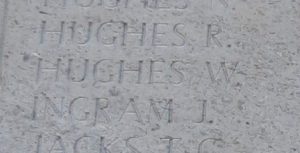
Richard Lewis Jones, Private, 291797, Royal Welsh Fusiliers. Richard was born at Llanerfyl in 1885, the son of Maurice and Anne Jones. His mother was from Llanbrynmair, and prior to the war the family had moved to Cae Twpa, Llanbrynmair. Richard worked as a horseman, and lived at Hafod, Llanerfyl, prior to enlisting into the 3/7th Battalion, Royal Welsh Fusiliers at Welshpool on 11 December 1915, and was initially placed on the Army Reserve. He was mobilised on 29 June 1916, joining the battalion at Park Hall Camp, Oswestry, and after completing his training, embarked for Egypt on 11 December 1916, joining the 1/7th Battalion, Royal Welsh Fusiliers, which was attached to 158 Brigade, 53rd (Welsh) Division. The Division had been evacuated from Gallipoli in December 1915, moving to Egypt to join the EEF, and helped guard the Suez Canal before taking part in operations to drive the Turks out of the Sinai. The EEF then turned its attention onto driving the Turks out of Palestine, and on 26 March 1917 launched its first offensive against the coastal city of Gaza, which guarded the road to Jerusalem. Initial gains during the day were lost when the assaulting divisions lost touch with each other and communication broke down when a thick fog cloaked the battlefield. A second attempt to force Gaza was launched on 17 April, which also failed, and the EEF suffered a change in leadership, with Sir Edmund Allenby assuming command, before being re-organised, and a third offensive was launched against a wider front from Beersheba to Gaza on 31 October 1917. This time the Turkish defences were breached, and the road to Jerusalem now lay open and the EEF began to advance north. On 6 November 1917, 158 Brigade launched an attack on the Khuweilfeh Heights, and once secured, the EEF continued its advance into the Judean Hills, the 53rd Division capturing Hebron and Bethlehem, before securing the Jerusalem to Jericho road. Allenby finally made his triumphant entry into Jerusalem on 11 December. The EEF continued the advance, following the retreating Turks. Richard was killed during an attack on Suffa, on the Jericho Road, on 28 December 1917. The 32-year-old is buried in Jerusalem War Cemetery, Israel. Richard is not commemorated on the Llanbrynmair war memorial.
John Peter Jones, Lance Corporal, 36998, Royal Welsh Fusiliers. John was the son of Peter and Jane Jones of Llwyncelyn, Llanbrynmair. He worked as a farm labourer at Ystradfawr, Llanbrynmair prior to the war. John enlisted into the 20th Battalion, Royal Welsh Fusiliers at Newtown on 22 November 1915, and was posted to Kinmel Park for training. On 16 June 1916 he embarked for France at Folkestone, and was posted to the 38th Infantry Base Depot, at Étaples. On 27 June 1916 John was posted to the 13th Battalion, Royal Welsh Fusiliers, which was attached to 113 Brigade, 38th (Welsh) Division. The Division had marched south to the Somme sector in June 1916 to take part in the assault on Mametz Wood. The first attack on the wood was launched on a two-battalion front on 7 July, but failed, and the Divisional Commander, Sir Ivor Philipps, was replaced before the Division attacked again on a two Brigade front on 10 July 1916. After two days of ferocious hand-to-hand fighting, the wood was cleared up to its northern edge, before the battered Division was relieved. It then took over a section of the front at Hébuterne before moving to the Ypres Salient, and taking over the Canal Bank sector at Boesinghe. The infantry battalions of the Division then began carrying out the normal pattern of rotation in the trenches, four days in the front, four in support and four in reserve, whilst also working on trench improvement, digging new trenches, and also carrying out regular patrols and trench raids. On 31 July 1917 the Division launched its famous assault on the Pilckem Ridge, capturing Iron Cross and reaching its objective of the Steenbeek, then played a supporting role in the Battle of Langemarck. John came home on two weeks leave on 23 September, after the division had been transferred to the Sailly-sur-la-Lys sector. The division remained in the area over the winter before being moved to positions north of Albert, at Bouzincourt Ridge, at the end of March 1918, relieving the battered 2nd and 47th Divisions. It held this sector, again carrying out minor operations and trench raids, over the coming months, before taking part in the great offensive of 21 August 1918, and began its advance towards the Hindenburg Line. The 13th RWF advanced through Albert on 22 August, and on the following day, 23 August 1918, joined the offensive, assaulting a line running from Crucifix Corner to the Albert to Bapaume Road. Peter was killed in action during the attack that day. The 31-year-old is buried in Aveluy Wood Cemetery, Mesnil-Martinsart, France.
John Peate, Lieutenant, Gloucestershire Regiment. John was born at Llanbrynmair in 1889, the son of Margaret Peate of Ddolfach. He was educated at Machynlleth and Aberystwyth University, and was on the staff at Greenhill Grammar School, Tenby prior to the war. John married Ethel Gertrude Hicks at Tenby in 1915 and the couple lived at Marlborough House, South Cliff Street, Tenby. John was commissioned into the 3rd Battalion, Gloucestershire Regiment, and was posted into the 1st Battalion, Gloucestershire Regiment, which had been in France since the outbreak of war, attached to 3 Brigade, 1st Division. John joined the battalion in time to take part in the Somme Offensive on July 1916, probably arriving before the 1st Division moved to the Somme from Loos. By 5 July the 1st Gloucester’s had reached Bruay, and moved to billets in Albert by 11 July, prior to moving into the front line near Contalmaison. The 1st Division saw its first action on the Somme during the Battle of Bazentin soon afterwards, fighting to the right of the Australians as they assaulted Pozieres Ridge, and suffered terribly during the fighting around the OG lines. Heavy fighting, interspersed with rest periods, carried on over the coming weeks. By 7 September the 1st Gloucester’s moved into positions to carry on the offensive towards High Wood, and at dawn on the following morning launched their assault. Unfortunately, the artillery support fell short, and many casualties were suffered from friendly fire. John was killed when the 1st Gloucester’s attacked High Wood on 8 September 1916. The 27-year-old has no known grave, and is commemorated on the Thiepval Memorial, France.
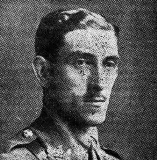
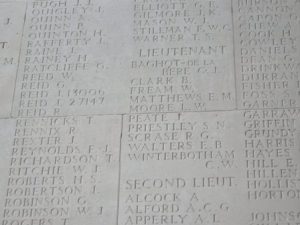
Loscombe Law Stable, Captain, Royal Welsh Fusiliers. Loscombe was born at Wanstead Lodge, Wanstead on 21 March 1886, the son of Daniel Wintringham Stable, JP, LLB, Director of the Prudential Assurance Company, and his wife, Gertrude Mary Stable (nee Law). The family later resided at Plas Llwyn Owen, Llanbrynmair. Loscombe was educated at The Wells House School, Malvern Wells, then at Winchester College and the Royal Military Academy, before being commissioned as a regular officer into the Royal Welsh Fusiliers 2 February 1907, and became a Lieutenant on 11 April 1911. He served with the 2nd RWF in India and was a member of the battalion polo team. When war broke out, he was serving with the 3rd RWF at Wrexham, but he soon joined the 2nd RWF, moving to France with the battalion on 13 August 1914. The battalion was initially placed on Lines of Communication at Rouen, before joining 19 Brigade at Valenciennes, taking part in the retreat to the Marne with the BEF. Loscombe gained fame among his fellow officers during the retreat by procuring a travelling draper’s cart, which the battalions officers used as a mess cart for the rest of the war. Following the Battles of the Marne and the Aisne, 19 Brigade moved to Flanders with the BEF, and eventually took over the La Boutillerie sector after becoming attached to the 6th Division. Loscombe served with B Company, and had been promoted Captain, taking command of B Company, on 21 October. Soon afterwards, on 26 October 1914, Loscombe bravely went out into No Man’s Land, to attempt to rescue one of his men, Private Ellis, who had been wounded. Loscombe came under a hail of bullets during the rescue, and fell down mortally wounded in the side, dying soon afterwards. The 28-year-old was originally buried by the Brigade Chaplain at La Cordonnerie, but after the war his grave was exhumed, and he was re-interred in Pont-du-Hem Military Cemetery, La Gorgue, France. His Commanding Officer, Lieutenant Colonel Delmé-Radcliffe was invalided on the day, and wrote: ‘He was a most excellent soldier, fearless to a degree, and always the most cheerful of companions, and was therefore most popular with his brother officers, and his death is most deeply regretted by all ranks he was a model of unselfishness, and thoughtfulness for others.’ Loscombe is also commemorated on the Wanstead War Memorial and at Winchester College. His brother, Sir Wintringham Law Stable, MC, served with the Montgomeryshire Yeomanry and Royal Welsh Fusiliers during the war, gaining the Military Cross and being promoted to Major. He died at Llanbrynmair on 23 November 1977.
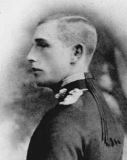
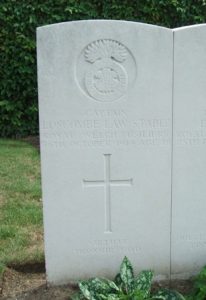
Russell Colin Stable, Second Lieutenant, Royal Warwickshire Regiment. Russell was born at Preston, Lancashire in 1897, the only son of Major Russell Loscombe Stable and Marian Emma Stable (nee Campbell). His mother died at 22, Clifton Crescent, Folkestone on 7 September 1900, and his father remarried Edith Anna Bayly, but had himself died on 29 May 1912. By then Russell was a boarder at Red Cottage, and was attending Cordwallis School in Maidenhead, Berkshire. Russell was commissioned into the Royal Warwickshire Regiment in April 1917 and embarked for France on 11 July 1917, joining the 2nd Battalion, Royal Warwickshire Regiment, which was attached to 22 Brigade, 7th Division, and was situated at the time near Mory, in the Arras sector, carrying out the normal routines of trench rotation. In September the Division withdrew from the Arras sector and moved to Wizernes, where it received orders to entrain for Ypres, and by 29 September had reached camp at Dickebusch, in the Ypres Salient. By 1 October the 2nd Warwick’s had moved close to the front line, near Hooge Crater, and the battalion was supplying working parties carrying ammunition to the 1st RWF. By 7 October the 2nd Warwick’s took over a section of line east of Polygon Wood, setting up HQ at The Butte, within the ruins of the wood. Two days later, at dawn on 9 October 1917, in terrible weather, the Battalion attacked German positions around Judge Copse, north-east of Reutel. The attacking troops were hit by concentrated machine-gun fire from the German defenders, and Russell was killed near the village cemetery. The 20-year-old has no known grave and is commemorated on the Tyne Cot Memorial, Belgium. He was the first cousin of Loscombe Law Stable, above.
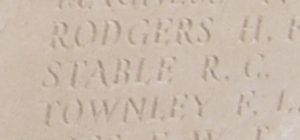
Abram Thomas, Private, 4382, Royal Welsh Fusiliers. Abram was the son of Evan Thomas and Mary Thomas (nee Peate) of Penddol, Llanbrynmair. He worked as a shoemaker prior to the war, and was the winner of three bardic chairs, which he had won between the ages of fifteen and twenty. Following the outbreak of war, Abram enlisted into the 3/7th Battalion, Royal Welsh Fusiliers. He was posted to Park Hall Camp, Oswestry for training, but was already of poor health upon enlistment, and he was found to have contracted tuberculosis. Abram was sent to St. Woolos Hospital in Newport for treatment, but died of tuberculosis there on 15 September 1916, aged 34. He is buried in Newport (St. Woolos) Cemetery, Monmouthshire.
John Richard Thomas, Private, 291241, Royal Welsh Fusiliers. John was born at Pen Capel, Llanerfyl in 1888, the son of John Thomas and Margaret Thomas (nee Richards). After the death of his father, his mother moved to Henefail, Llangadfan, while John lived at Rhydymeirch, Llanbrynmair, where he worked as a farm labourer. He enlisted into the 3/7th Battalion, Royal Welsh Fusiliers at Newtown on 20 November 1915, and was posted to Park Hall Camp, Oswestry for training. On 26 June 1916 John embarked for Egypt, and joined the 1/7th Battalion, Royal Welsh Fusiliers, which was attached to 158 Brigade, 53rd (Welsh) Division. The Division had been evacuated from Gallipoli in December 1915, moving to Egypt to join the EEF, and helped guard the Suez Canal before taking part in operations to drive the Turks out of the Sinai. The EEF then turned its attention onto driving the Turks out of Palestine, and on 26 March 1917 launched its first offensive against the coastal city of Gaza, which guarded the road to Jerusalem. Initial gains during the day were lost when the assaulting divisions lost touch with each other and communication broke down when a thick fog cloaked the battlefield. A second attempt to force Gaza was launched on 17 April, which also failed, and the EEF suffered a change in leadership, with Sir Edmund Allenby assuming command, before being re-organised, and a third offensive was launched against a wider front from Beersheba to Gaza on 31 October 1917. This time the Turkish defences were breached, and the road to Jerusalem now lay open and the EEF began to advance north. On 6 November 1917, 158 Brigade launched an attack on the Khuweilfeh Heights. John was killed in action during the fighting that day. The 29-year-old has no known grave and is commemorated on the Jerusalem Memorial, Israel.
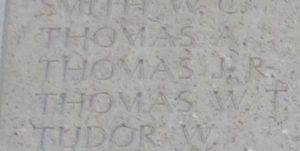
William Tudor, Private, 291251, Royal Welsh Fusiliers. William was the son of Tudor Tudor and Jane Tudor (nee Hughes), of Tynewydd, Dyliffe, Llanbrynmair. He worked as a shop assistant prior to the war. William enlisted into the 3/7th Battalion, Royal Welsh Fusiliers at Newtown on 20 November 1915, and was posted to Park Hall Camp, Oswestry for training. He embarked at Devonport aboard the HT Kalyan on 31 May 1916, and upon arriving in Egypt, joined the 1/7th Battalion, Royal Welsh Fusiliers, which was attached to 158 Brigade, 53rd (Welsh) Division. The Division had been evacuated from Gallipoli in December 1915, moving to Egypt to join the EEF, and helped guard the Suez Canal before taking part in operations to drive the Turks out of the Sinai. The EEF then turned its attention onto driving the Turks out of Palestine, and on 26 March 1917 launched its first offensive against the coastal city of Gaza, which guarded the road to Jerusalem. Initial gains during the day were lost when the assaulting divisions lost touch with each other and communication broke down when a thick fog cloaked the battlefield. William was posted as having been wounded in the right arm and thigh before he went missing on 26 March 1917. Some confusion then arose, which saw him being later posted as missing on 26 May 1917, and he was eventually accepted as having been killed in action on 26 March 1917, during the chaos of the First Battle of Gaza. The 22-year-old has no known grave and is commemorated on the Jerusalem Memorial, Israel.
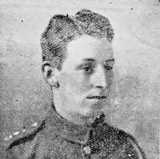
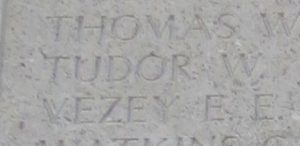
Moses Thomas Watkin, Private, 55529, Royal Welsh Fusiliers. Moses was the son of John Watkin and Jane Watkin (nee Hughes) of Bont, Dolgadfan, Llanbrynmair. He worked as a cowman at Ty Gwyn, Llanbrynmair prior to the war. Moses enlisted into the Montgomeryshire Yeomanry at Llanbrynmair, and after completing his training was drafted to France in the winter of 1916-17, joining the 17th Battalion, Royal Welsh Fusiliers, which was attached to 115 Brigade, 38th (Welsh) Division. The Division had taken part in heavy fighting at Mametz Wood in July 1916, and after being relieved had taken over a section of the front at Hébuterne before moving to the Ypres Salient, and taking over the Canal Bank sector at Boesinghe. The infantry battalions of the Division then began carrying out the normal pattern of rotation in the trenches, four days in the front, four in support and four in reserve, whilst also working on trench improvement, digging new trenches, and also carrying out regular patrols and trench raids. On 31 July 1917 the Division launched its famous assault on the Pilckem Ridge, capturing Iron Cross and reaching its objective of the Steenbeek. Moses was killed in action during the fighting that day. The 26-year-old has no known grave and is commemorated on the Ypres (Menin Gate) Memorial, Belgium.
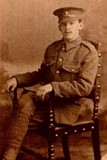
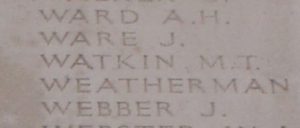
World War Two, 1939-1945
Gwilym Richard Evans, Sergeant, 1196508, Royal Air Force Volunteer Reserve. Gwilym was the son of Richard and Mary Louisa Evans of Llanbrynmair. He enlisted into the Royal Air Force Volunteer Reserve, and after completing his training as an Air Gunner was posted to 49 Squadron, RAF, which was a Bomber Command squadron, based at RAF Fiskerton. On the night of 23 May 1943, Gwilym took off from Fiskerton aboard Lancaster ED813, which was part of a force sent to bomb targets in Germany. In the early hours of 24 May 1943, the Lancaster crashed into the ground near Essen, killing Gwilym and three other crewmen. The 23-year-old Gwilym was originally buried alongside his fellow crewmen at Dusseldorf North Cemetery, but on 3 October 1946 the four graves were re-interred in Reichswald Forest War Cemetery, Germany.
John Hartwell Goodwin, Private, 4037915, Royal Army Service Corps. John was born at Llanbrynmair on 27 September 1915, the son of Richard Goodwin and Annie Laura Goodwin (nee Smith). He worked as a bricklayer at Wellington, Shropshire prior to the war and married Rhoda Jane Smith, of Leegomery, in the spring of 1942. John enlisted into the Royal Army Service Corps, and was stationed near Maidstone, Kent, when he died on 2 October 1942, aged 25. He is buried in Llanbrynmair Congregational Chapelyard Extension, Wales. John is not commemorated on the Llanbrynmair war memorial.
John Cledwyn Hughes, Ordinary Seaman, P/JX 227718, Royal Navy. John was born on 21 May 1920, the son of Hugh Alfred Hughes and Kathleen Hughes (nee Jones) of Llanbrynmair. He enlisted into the Royal Navy, and after completing his training, was posted aboard the light-cruiser HMS Fiji. The ship had been built by John Brown, Clydebank and launched on 31 May 1939, and was initially assigned to the Home Fleet, before sailing for the African coast. She was torpedoed en-route, but managed to return to England for repairs. Returning to service in March 1941, she was assigned to Force H, at Gibraltar, and took part in operations to relieve Malta before joining the Mediterranean Fleet. The Germans launched an airborne attack on the Island of Crete on 17 May 1941, and the Mediterranean Fleet put to sea, and on 22 May German aircraft sighted the fleet and began a series of aerial attacks. The fleet put up a desperate defensive screen of anti-aircraft fire, and by the afternoon Fiji ran out of ammunition, sealing her fate, and was mortally wounded when she was struck by a bomb which hit her amidships. The stricken cruiser was hit again before capsizing that evening. John is officially listed as having been killed on 23 May 1941. The 21-year-old has no known grave and is commemorated on the Portsmouth Naval Memorial, Hampshire.
